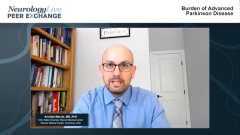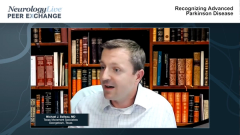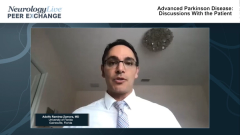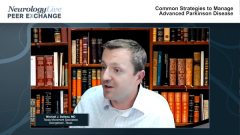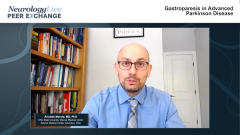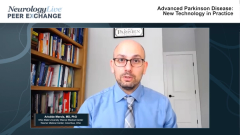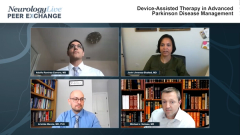
Progression of Advanced Parkinson Disease
Joohi Jimenez-Shahed, MD, describes the natural progression of Parkinson disease from the time of diagnosis to advanced disease.
Episodes in this series

Adolfo Ramirez-Zamora, MD: Joohi, briefly talk about this progression of the natural course expected in Parkinson disease. Now you mentioned the heterogeneity, how different these patients are. You reminded me I had this patient the other day walk into the office, and I said, “How are you doing?” He’s like, “Listen, after sitting in your waiting room for 5 minutes, I’m doing great, so I have no complaints.” But you have to try to figure out what are their challenges, right? It needs to be individualized; it needs to be custom to the patients. But I think it would be useful for the audience, Joohi, if you can guide us quickly about the natural trajectory of most patients with Parkinson disease, from the time of diagnosis to the years to come.
Joohi Jimenez-Shahed, MD: I think you hit it on the head by prefacing it by saying there is a lot of heterogeneity, and everybody is going to be a little different. So even though we might talk about typical progression, you’re going to find nuances in everybody. It’s important to remember that we may be able to think in certain terms, but it’s still important to talk to the patients and try to find out how they’re experiencing the symptoms. Michael did a great job of talking about some early Parkinson disease scenarios where patients may have some symptoms, where it might not even be clear that it’s Parkinson disease, but eventually the disease declares itself.
Once patients hopefully are able to get that accurate diagnosis, we talk about starting treatments. There may be different reasons for choosing different treatments, or choosing not to treat, or waiting for a bit, but that’s again a very individual conversation. If a patient does choose to start medication, it’s usually to address the motor symptoms. That’s where a lot of our medication management lies; it surrounds treating the tremor, the rigidity, the bradykinesia, maybe gait disturbance as well. Those are symptoms we expect to improve with the medications.
Over time, as the disease progresses, whatever dose the patient was taking of those medications may not work as well anymore. Maybe they feel more of those same symptoms, maybe they start developing a new tremor that they didn’t have before or new gait problems that weren’t present previously. So, we have to be careful to be in close conversation and in close touch with our patients so that we can monitor for these changes, talk to them about it, and determine if it’s appropriate to adjust.
Then we talked a little about the wearing-off effects they might experience. Some of that wearing off, as Ari was talking about, could be motor, but also could be nonmotor. Maybe patients become more anxious, or their mood changes, or it’s a little harder to think clearly during the times that their medications wear off. We have to be aware of these symptoms as well.
A lot of the medication management we do, as I’ve talked about, relates to the motor symptoms, but there are management strategies for some of these nonmotor things as well. Then we may want to incorporate some of those into our medication strategy. I should also mention that there are a number of adjunctive therapies we can do, things like physical therapy, speech therapy, occupational therapy, and exercise that we often encourage our patients to do to live healthier [lives] and to stay active, to help mitigate some of this progression and development of worsening symptoms. Then, unfortunately, as time goes on, we know there can be other symptoms that are hard to treat with medications. Those may be things like the cognitive issues, or swallowing might be difficult for patients, certain gait issues like balance, or maybe if they develop gait freezing as time goes on. Those are some of the symptoms that become increasingly difficult to manage from a medication standpoint, and then we do have to use some of these other adjunctive therapies.
Adolfo Ramirez-Zamora, MD: Absolutely, that’s great. I have 2 questions that came from the discussion that I have to ask. No. 1, when do you start treatment with your patients? What’s that clinical threshold for you? I know it has to be based on individual patients, but it would be great for the audience to hear from the experts, when do you think it’s a good time to start medications? Also, is it useful to define early, intermediate, and advanced Parkinson disease? There has been some suggestion that early is defined as after diagnosis before you have motor complications, and intermediate may be when you have motor complications, motor problems, and then advanced is once you develop cognitive problems, recurrent falls, or severe dysphasia. Do you think that framework is useful or not? Ari, would you comment a little about this?
Aristide Merola, MD, PhD: Sure. I don’t think it’s very helpful to put specific boundaries and define it as early, intermediate, or advanced, because we know that Parkinson disease is very heterogeneous. We can have young-onset patients and late-onset patients; 30% of patients have symptoms such as orthostatic hypotension, and some patients may have hallucinations. Synthesizing these into 1 single definition—early, intermediate, or advanced—I think is not the best approach; I’m not in favor of that. I believe it’s important to have some sort of clinimetric assessment of the symptoms. It’s becoming important to use scales, such as the Unified Parkinson’s Disease Rating Scale, especially the Movement Disorder Society version, which improved upon the original scale, and also the Non-Motor Symptoms Scale [for Parkinson disease]. It’s important to keep tracking their symptoms.
In terms of starting medications, I think we should be aware that every single medication for Parkinson disease so far is just a symptomatic medication. When should we start it? We should start it when the symptom the patient is experiencing starts to have an impact on his quality of life. Sometimes patients fight this. Even though they have a lot of bradykinesia, they have a certain degree of tremor, and clearly there is an impact of the symptoms on their quality of life, they don’t want to start the medication because they are scared about it, or they have a lot of prejudice about developing tolerance or [adverse] effects. But if we believe that symptom is severe enough to cause an impact on quality of life, I believe we should start medication.
This doesn’t apply only to motor symptoms. In my vision, this applies also to nonmotor symptoms. When is the right moment to start a medication for hallucinations? When is the right moment to start a medication for orthostatic hypotension? When is the right moment to start a medication for cognitive deficits? I think as Parkinson disease experts, we should take a look at all of the symptoms, and in my view, when the symptom is disabling, and has a clear impact on the patient’s functionality, that’s the right moment to start it.
Adolfo Ramirez-Zamora, MD: Thank you all for watching this NeurologyLive® Peer Exchange, and if you enjoyed the content, please subscribe to our e-newsletter to receive upcoming Peer Exchanges and other great content right in your inbox. Thank you so much.
Transcript Edited for Clarity
Newsletter
Keep your finger on the pulse of neurology—subscribe to NeurologyLive for expert interviews, new data, and breakthrough treatment updates.

